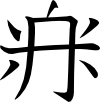The Khitan (AKA Liao) Empire was in charge in Manchuria (northeastern China) for a while, and the local Jurchen people used the Khitan script and Chinese script for their writing. They rebelled and overthrew their Khitan overlords in 1115, and four years later, at the new emperor’s request, Wanyan Xiyin made a new script for Jurchen, called “Large Script”. In 1138, Emperor Xizong made a new script (called “Small Script”).
Jurchen got most of its glyph shapes from Chinese script and Khitan script. In addition to logograms, they had many phonetic characters which were used for word endings and for words which didn’t have a logogram. The phonetic characters were usually syllables, but they also had standalone vowels and syllables that were “vowel+n”. I have no idea how to classify that: sort of an inverse abjad? This just shows how complex writing systems are!
Note that Jurchen came from Chinese and Khitan; Khitan came from Chinese but with inspiration from Old Uyghur; Old Uyghur came from Sogdian; Sogdian came from Aramaic or Syriac; Syriac came from Aramaic; Aramaic came from Phoenician. It might have taken 2000 years, but Phoenician’s descendants spread eastwards 6000 miles, across a continent, before internal combustion engines. That’s pretty cool.


Pingback: Hangul — 1446 AD, Korea | Glyph of the Day